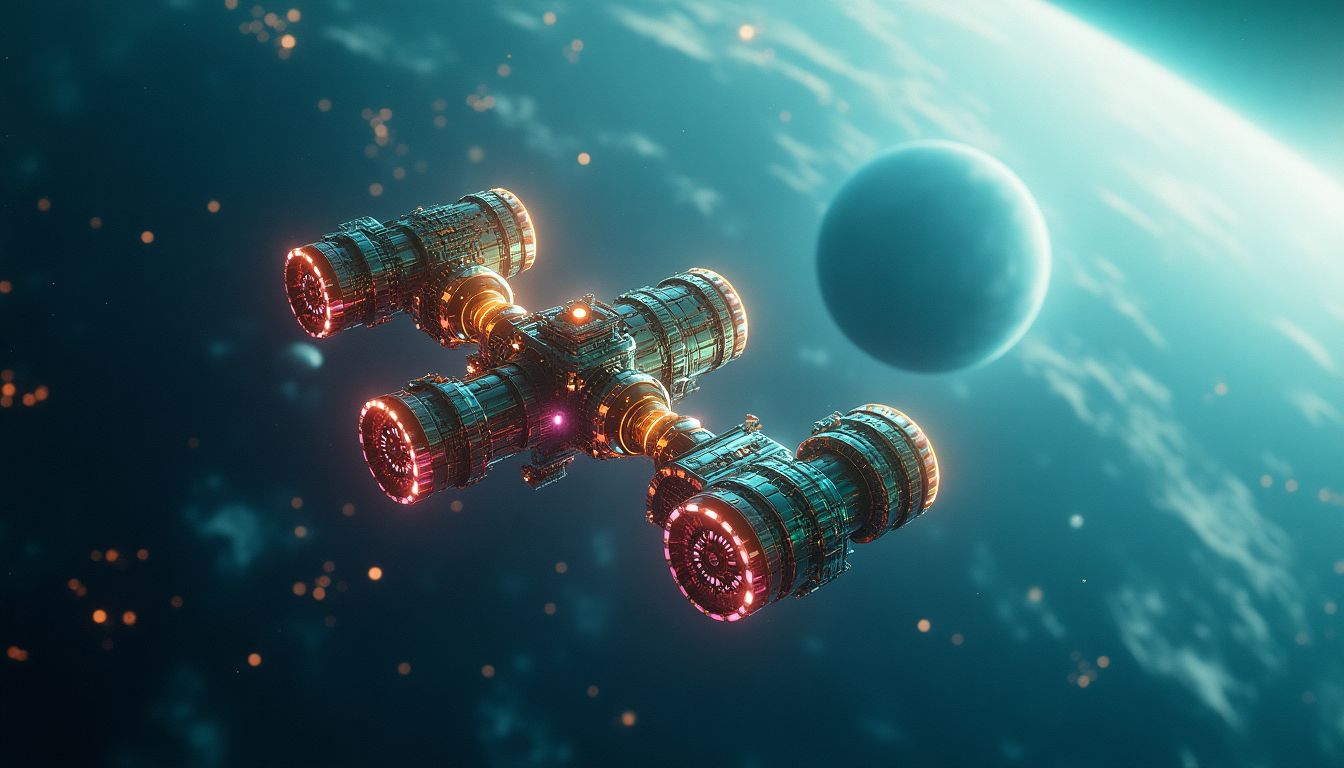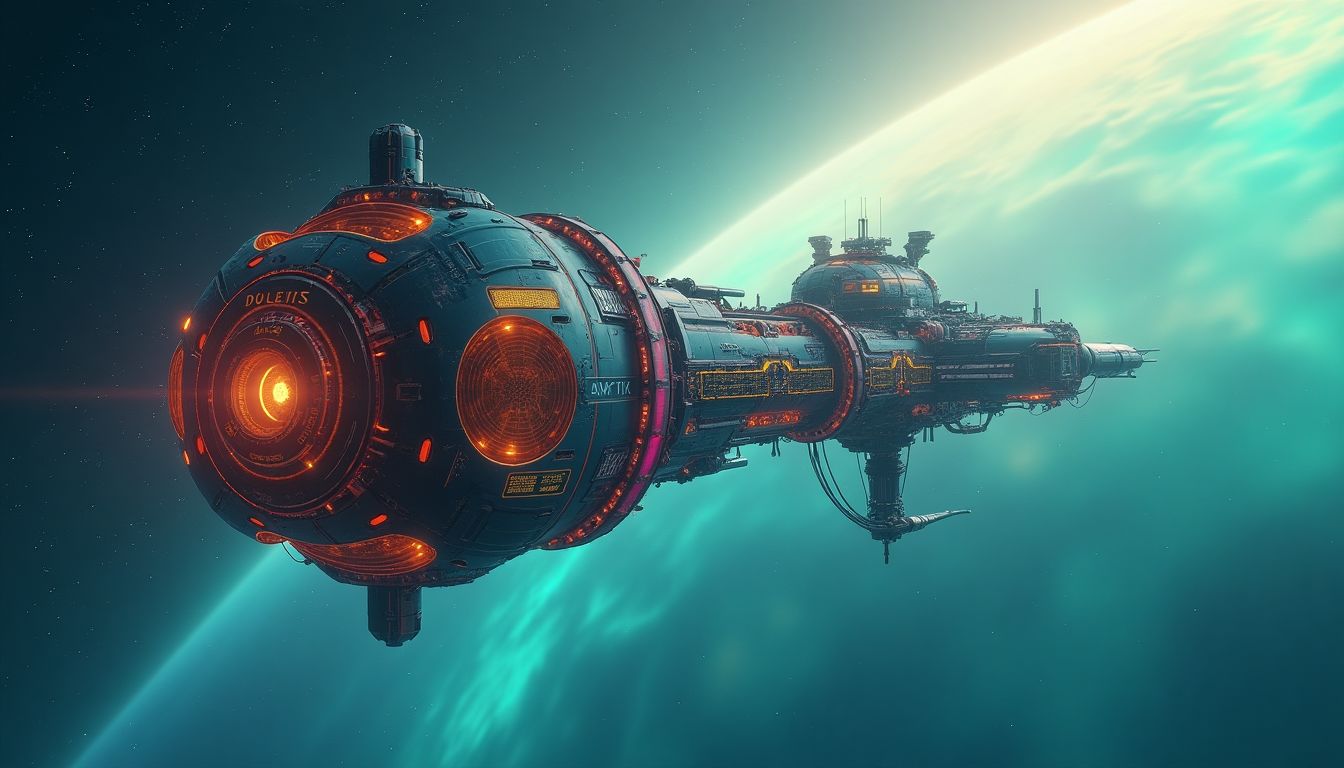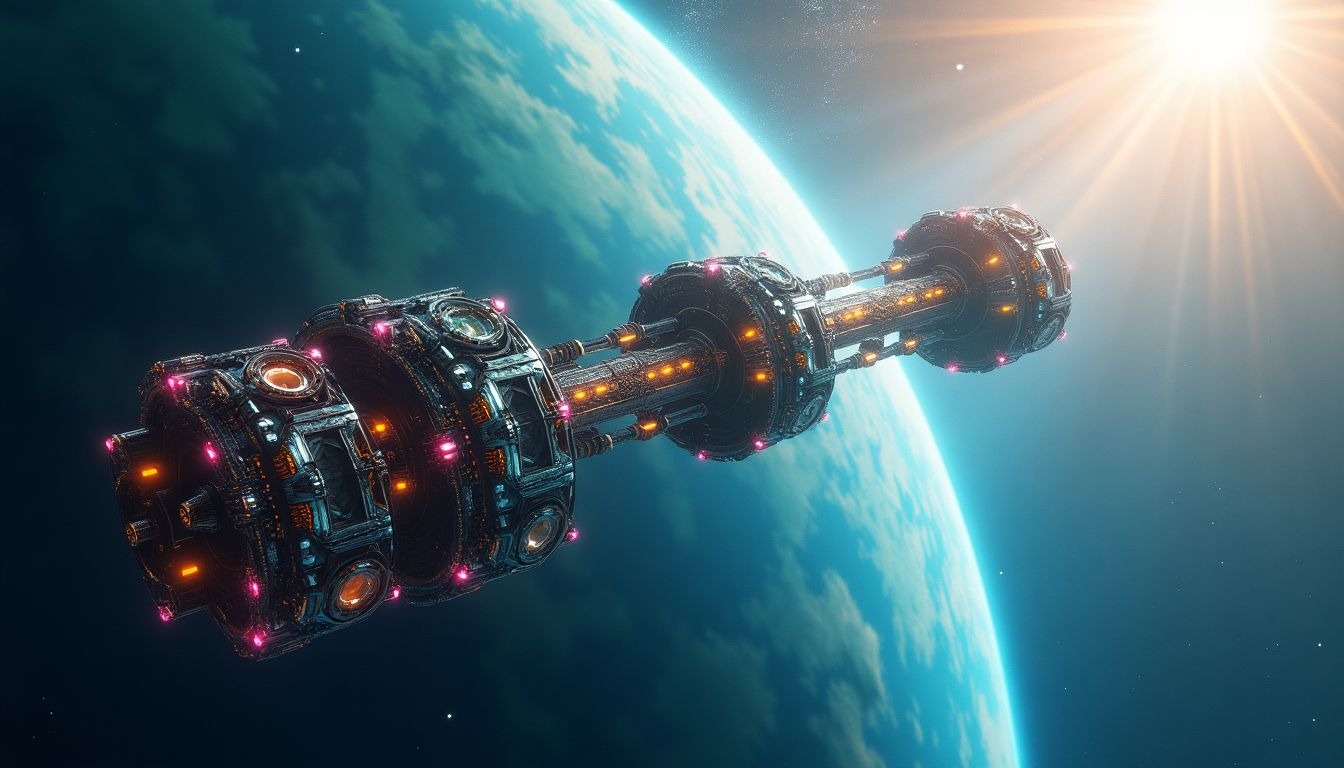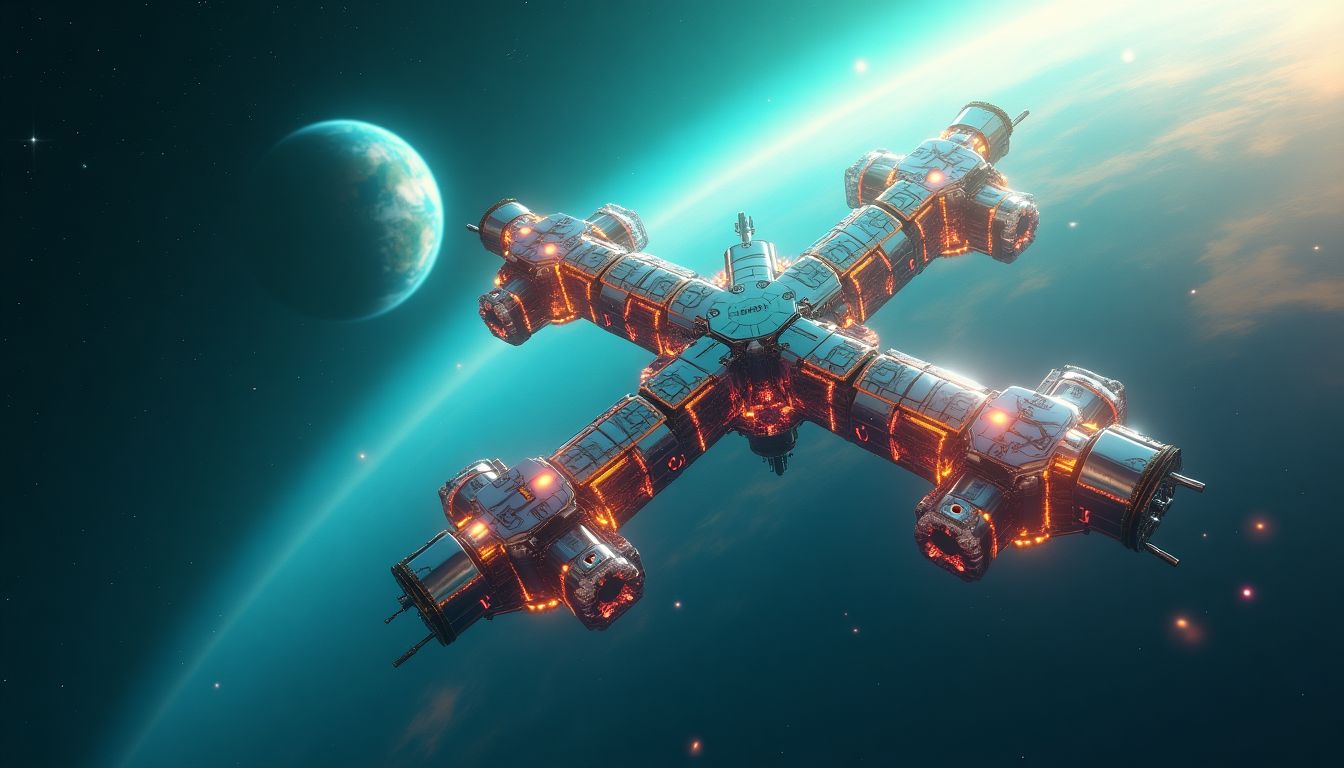Stars shimmer against an infinite black canvas, and within this cosmic theater, humanity is scripting its audacious next act: designing habitats for interstellar living. But here’s the twist—these architectural marvels won’t bear the hallmark of human creativity alone. Artificial Intelligence, with its unmatched capacity to crunch massive datasets, simulate far-flung scenarios, and optimize designs beyond human comprehension, is poised to take center stage. It’s a revolution that luminaries like Isaac Asimov, Stephen Hawking, and Elon Musk all foresaw but could only describe in broad strokes. What they primarily envisioned has now started to crystallize with AI’s accelerating development and our palpable ambition to transcend Earth's boundaries.
Why does this matter? Because space is the ultimate test of survival. Extreme cold, radioactive storms, resource scarcity, and a vacuum of atmosphere paint a harsh environment that no human could navigate unaided. If we’re to dream of thriving on Martian regolith or orbiting an exoplanet trillions of miles from home, traditional engineering and architecture may fall short. Enter Artificial Intelligence. From modular architecture optimized for functionality and durability to life-support systems tailored for future challenges, AI transforms extraterrestrial colonization from a bit of sci-fi daydreaming into an imminent possibility.
This article delves into how AI is revolutionizing the design of space stations built to endure the trials of deep space while supporting human life for decades. Expect insights on modularity trends, life-support breakthroughs, and tangible solutions to radiation shielding, as well as discussions on the ethical dilemmas of giving AI a say in survival-critical decisions. Let’s look at not just the mechanics of tomorrow’s space habitats but also their potential to define humanity’s future far beyond Earth. In the spirit of relentless curiosity, the question isn’t, “Can we do this?” It’s, “How soon before we do?”
1. The Challenges of Extraterrestrial Living
1.1 Extreme Environmental Factors
Outer space is less a place and more an unyielding expanse of hostile conditions, almost daring humanity to survive. Among the greatest threats, radiation stands tall. Galactic cosmic rays and solar particle events can damage DNA and increase cancer risks exponentially, according to studies by NASA. Traditional shielding methods such as aluminum have proven insufficient, which opens doors for AI-led exploration of advanced materials. Strong contenders include hydrogen-rich polymers and regolith-based composites repurposed through in-situ resource utilization—a fancy way of saying we build with the dirt we find on the Moon or Mars.
Then there’s the vacuum of space, where zero atmospheric pressure tears at the tiniest structural flaw and sends shrapnel hurtling through the void in a flurry of metal confetti. AI’s ability to detect microfractures before they spread could save lives, making real-time, intelligent threat monitoring indispensable in these builds. And let’s not forget temperature extremes. Spacesuits regularly combat temperatures swinging between a bone-chilling -250°F and infernal 250°F. Modern material solutions are being spearheaded by groups like ILC Dover, which integrate AI-driven sensors to learn from thermal data and adapt accordingly.
1.2 Resource Scarcity
Space doesn’t come with convenience stores. Water, food, and power must all be accounted for meticulously. Take water. Recycling systems aboard the International Space Station (ISS), such as NASA’s Water Recovery System, claim a 98% efficiency rate, yet they still rely on finite reserves transported from Earth. AI can optimize these recovery systems by fine-tuning thresholds based on consumption data, potentially achieving perfect closed-loop efficiency.
Power shortages pose another hurdle. Solar panels are brilliant but susceptible to inefficiency during dust storms that bury panels under fine particles, as researchers at NASA Mars Exploration have observed firsthand. An integrated AI monitor could adjust panel angles and placement dynamically to maximize energy generation at any given moment, ensuring crews don’t perish due to a lack of electricity.
Food scarcity forms the third leg of the resource dilemma. Agriculture in zero gravity isn’t as simple as introducing soil and seeds. Nutrient cycles shift unpredictably, and water clings to surfaces in bizarre blobs, complicating irrigation. Projects like ESA’s MELiSSA experiment are working to create AI-managed biospheres where waste materials feed plant growth, closing the nutrient loop. It’s an infant solution but shows promise if AI’s precision orchestration takes the lead.
1.3 Psychological and Physiological Risk
Even if we solve the above technical issues, humans remain fragile creatures thrust into prolonged isolation with limited distractions. Cabin fever doesn’t even begin to describe what could happen on multi-year Mars journeys. AI shines here, too, monitoring crew behavioral and emotional states using biometric sensors embedded in workstations or wearables. Real-time interventions—sometimes as mundane as tweaking lighting color to simulate Earth’s daily cycles—can alleviate mounting stress. Companies like Neurosity already specialize in emotion-detecting tech, showcasing the convergence of neuroscience and AI into daily operations in high-stakes environments.
The skeletal system, meanwhile, screams rebellion against zero gravity. With bone density dropping by 1% per month of exposure, artificial gravity systems based on centrifugal force might mitigate degradation in tomorrow’s space stations. Pairing these with AI-driven fitness routines could turn weakening muscles and brittle bones into manageable, monitored health factors rather than mission-compromising failures.
2. The Modular Revolution: Redefining Space Habitats
2.1 What is Modular Design?
Modular design can be likened to a LEGO set for space habitats—each component is an independent, replaceable unit that can be assembled in different configurations depending on mission demands. This approach offers flexibility, scalability, and cost-efficiency in building structures that must endure unexpected challenges. NASA, for instance, is leaning heavily on modularity for plans like the Lunar Gateway, which aims to serve as a waystation for deep-space missions. SpaceX is no stranger to modularity either, with their Starship platform designed to adapt to various roles from cargo transport to Mars colonization. This modular philosophy isn’t just practical—it’s the cornerstone for scaling humanity's presence beyond Earth.
2.2 Modular Components in AI-Driven Space Design
AI takes modular design to extraordinary levels by making real-time decisions on how to configure habitats for efficiency, safety, and sustainability. Consider modular living quarters. Rather than being static, AI can custom-design these spaces, adjusting them dynamically for crew size, resource availability, or changes in mission requirements using advanced simulation tools. Workspaces can also become expandable. AI might design these areas to serve dual purposes—research instruments by day, manufacturing zones by night—ensuring no inch goes to waste.
Moreover, connectivity is key. By embedding AI sensors within these modules, they become "smart nodes," ensuring life-support systems, power management, and even interpersonal dynamics function harmoniously. These interconnected networks are the AI equivalent of a living, breathing organism—a profoundly efficient one. Take the Fractional Systems concept as an example, where every node contributes to a self-sufficient, symbiotic ecosystem.
2.3 Resilience through Modularity
Modularity isn’t just about adaptability; it’s about resilience. Imagine a catastrophe—an asteroid damaging part of a station. In a traditional habitat, this might cause total system failure. With AI-driven modularity, compromised systems could be isolated instantly, containing the damage. AI might even simulate scenarios for population growth, ensuring scalable expansion of habitats without compromising functionality.
Consider a potential future where modular habitats grow into entire cities staffed by autonomous systems. This level of adaptability moves modularity from a practical feature to an evolutionary necessity, facilitating humanity's leap from survival to thriving. With modular systems, space colonization doesn't just feel possible. It feels inevitable.
3. Life-Support Systems and Resource Optimization
3.1 AI-Driven Life-Support Mechanisms
Human life is unforgivingly fragile—and nowhere is this more evident than in the vacuum of space. AI can tackle this vulnerability head-on with the precision of a surgeon and the foresight of a chess grandmaster. Take atmospheric regulation, for example. AI can continuously monitor oxygen, carbon dioxide, and humidity levels in real-time. Innovations like NASA's Water Recovery System, which recycles 98% of wastewater—including sweat and condensation—are not just vital for astronauts; they serve as inspiration for AI-driven improvements in efficiency.
Beyond recycling, AI could automate worst-case scenario responses. Suppose oxygen levels drop suddenly. Smart systems embedded with predictive analytics could neutralize the crisis before astronauts even realize there’s a problem. The ability to collect and react to biometric and ecosystem data gives AI its edge in critical life-support domains.
3.2 Energy Solutions
Energy is the heartbeat of a space station. Without it, even the most genius designs crumble. AI is already proving its worth in optimizing solar energy systems. Imagine solar arrays that adjust their angles in response to the sun's position, maximizing output at all times. Companies like Maxeon Solar Technologies are demonstrating how solar panels managed by AI can achieve unparalleled efficiency on Earth—imagine their potential in space.
But what if solar power isn’t enough? For deep-space missions far from the Sun, AI could play a key role in advancing prototype fusion reactors. Early research into potential game-changers like Helion Energy’s revolutionary fusion technologies may see the light of realization when AI is hand-in-glove with sustainable energy innovation.
3.3 Agricultural Integration
The phrase “farm-to-table” doesn’t just apply to Earth dining anymore! Feeding humans far from home presents unique challenges that AI is perfectly positioned to tackle. From vertical farming in microgravity to nutrient monitoring, AI can optimize every aspect of in-space agriculture. Picture AI-controlled irrigation tailored for each plant, where water delivery systems are fine-tuned to reduce waste and enable consistent growth.
One case study to watch is the European Space Agency’s MELiSSA project. This closed-loop system uses AI to manage oxygen generation, waste processing, and nutrient recycling in a miniature biosphere. It’s not merely a proof of concept—this interconnected system shows how AI can mimic Earth’s lifecycle while thriving in alien conditions.
The potential is staggering. Why wait until we reach Mars? AI-powered food systems could help solve food shortages right now, on Earth, while simultaneously refining the technologies needed for extraterrestrial expansion.
4. Building Habitability: Radiation Shielding, Materials, and Comfort
4.1 Radiation Shielding
Life in space comes with one major nemesis: radiation. Without Earth's magnetic field and atmosphere, astronauts are exposed to galactic cosmic rays and high-energy solar particles. Enter AI, the unsung hero of intelligent shielding. With its ability to simulate and analyze millions of variables, AI isn't just designing shielding for today—it’s future-proofing habitats for the unknown cosmic onslaughts of tomorrow. Imagine an AI recommending a cocktail of polyethylene and Martian regolith to not only block radiation but also utilize in-situ resources. Crazy? Not at all. In fact, research initiatives like NASA’s International Space Station program are already exploring these concepts.
Dynamic shielding could be the next frontier. Picture this: AI models quickly detecting solar storms, prompting the redistribution of "smart shielding" materials to areas of higher vulnerability. Using particle flux data in real-time, this adaptive approach turns a rigid protective design into a shape-shifting shield designed for survival.
4.2 Advanced Building Materials
AI has elbowed its way into material discovery, leveraging deep learning models to identify compounds that surpass human discovery rates by decades. One prime example is AI-pioneered basalt fiber composites, which are extracted from volcanic material readily available on Mars. This lightweight, tensile-strength miracle material outpaces traditional aluminum alloys in both durability and cost-efficiency.
But here's the kicker: AI doesn’t stop at simply identifying promising materials. It incorporates processing constraints, mining logistics, and manufacturing adaptations for off-world conditions. For instance, AI simulations suggest that 3D printing using regolith—a fine dust abundant on the Moon and Mars—can produce robust concrete-like panels, reducing reliance on Earth-bound supply chains.
| Material | Advantages | Use Cases |
|---|---|---|
| Basalt Fiber Composites | High tensile strength, lightweight, thermal resistance | Load-bearing walls, pressure hulls |
| Hydrogen-Rich Polymers | Exceptional radiation blocking | Radiation shielding layers |
| 3D-Printed Regolith | Abundance, low cost, structural integrity | Habitat walls, flooring |
4.3 Enhancing Human Comfort
Life in a space station shouldn’t feel like an endless trip through a sensory deprivation chamber. AI understands that human comfort is as important as survival. It seamlessly blends engineering with neuroscience. Think of it as the interior designer of the cosmos. Using machine learning algorithms trained to analyze crew stress levels, AI can customize habitat ergonomics. From simulating natural sunlight to designing soundscapes that soothe frayed nerves, it’s the little touches that make long-term missions bearable.
AI also monitors environmental factors like temperature and acoustics. A study by the European Space Agency (ESA) revealed the detrimental effects of inconsistent thermal and noise conditions on astronaut productivity. AI precisely adjusts climate systems and noise damping to ensure that missions are as pleasant as they are productive. This is where technology meets humanity in the most profound sense.
5. Autonomous AI Governance for Space Stations
5.1 AI as the Central Brain
Let’s talk governance—or, more accurately, the brains of the operation. Autonomous AI governance turns a space station into a living, breathing organism. Imagine it as the ship's captain, crewed entirely by algorithms. Decision-making algorithms process quintillions of data points every second, analyzing everything from oxygen levels to crew health. This isn't just hypothetical. The principles behind the autonomous systems of SpaceX missions have laid the groundwork for similar governance aboard space habitats.
Picture this scenario: A micro-meteorite punches through a module, causing an air leak. Before the crew even reacts, the AI has sealed the breach, rerouted oxygen, and alerted maintenance protocols. Or consider the day-to-day operations—AI dynamically assigns resources, such as adjusting energy consumption during low-solar-output periods without breaking a sweat (proverbially speaking).
5.2 Ethical Considerations
But here's the catch—we can’t hand over the keys to AI without setting some rules. Think of Asimov’s laws of robotics but with three layers of ethics sauce. The autonomy of AI in critical decision-making raises tough questions. What if a resource shortage forces a choice between habitat sections? Who decides that? Humans need a seat at the table, keeping AI decisions transparent and auditable.
The ongoing debate surrounding responsible AI usage has planet-sized implications. Organizations like the United Nations (UN) have floated guidelines for international space law, including accountability measures for autonomous systems. It’s not just about trust—it’s about ensuring collaboration between humans and machines instead of creating a sci-fi dystopia before it’s even necessary.
5.3 AI and Sustainability for Decades
An AI that evolves alongside its mission isn’t just futuristic. It’s essential. Self-learning systems act like a virtual Darwin. For instance, they continuously refine processes like waste recycling or climate control. Think: predictive maintenance. Before a hydroponics bay is at risk of failure, AI proactively schedules adjustments that keep it humming.
Long-haul missions—think decades-long ventures to exoplanets—depend on sustainability, and sustainability depends on AI. Consider NASA’s Mars initiatives, where AI plays a central role in processing planetary data for long-term habitat planning. With resource replenishment impractical for such missions, AI's ability to adopt minimalist designs and extend the lifespan of hardware will become an indispensable lifeline.
- Continuous monitoring of interconnected systems ensures that minor inefficiencies are instantly addressed.
- Scheduled material upgrades prevent degradation—like non-deflective shields being gradually replaced based on wear and tear assessments.
- Dynamic planning offers unmatched adaptability should conditions alter, enhancing the station's operational lifespan by decades.
In closing, AI isn’t just the tool of choice—it’s the partner humans always needed but never knew they wanted.
6. AI Solutions: Revolutionizing the Cosmic Blueprint
If humanity is serious about leaving its terrestrial cradle and establishing a permanent presence among the stars, it will be Artificial Intelligence—an untiring, ever-adaptive partner in design and strategy—that turns that vision into reality. In this section, we’ll dissect exactly how AI could tackle the monumental challenges of space station design and construction, and how a carefully orchestrated action plan could ignite this ambition within a realistic timeline.
6.1 Problem Framing: A Galactic To-Do List
Success begins with purpose. For AI to design a space station primed for extraterrestrial living, it must work from a comprehensive list of objectives, constraints, and contingencies. This "galactic to-do list" would include:
- Durability: Ensure module survivability against cosmic radiation, micrometeoroid impacts, and thermal fluctuations.
- Resource Independence: Create closed-loop systems for water, air, and food that minimize external resupply missions.
- Psychological Health: Factor in human comfort, communal spaces, and mental well-being for long-term missions in confined environments.
- Scalability: Design modular habitats capable of organic expansion as populations and resource needs increase.
AI brings clarity to these goals, eliminating inefficiencies and human biases through relentless data processing. But the real magic unfolds in how AI exceeds even our own expectations, discovering novel solutions through unsupervised neural networks and generative models.
6.2 Simulate, Iterate, Perfect
The first step isn’t pouring concrete or mining Martian regolith—it’s simulation. AI systems like reinforcement learning models will simulate thousands of complex extraterrestrial environments. Picture an AI running a billion “stress tests” simultaneously: solar flares frying circuitry, meteor impacts puncturing hulls, temperature extremes straining habitat materials. Each scenario offers a cascade of new data for the algorithm to process and adjust for future iterations.
Take radiation shielding as an example. By combining supervised learning with real-world data from past missions like Apollo and Mars rovers, AI could pinpoint the exact thickness and composition required for effective shielding while minimizing weight—possibly using hydrogen-rich materials like polyethylene or in-situ Martian soil.
This iterative cycle ensures that each prototype is an evolution in strength, efficiency, and cost-effectiveness. Like an artist perfecting their craft, AI hones the blueprint with each run, moving closer to an ideal solution.
6.3 Designing from the Ground Up with AI
Let’s dive deeper into how AI would physically design and construct a space station:
- Modularity: AI uses generative design tools to create interlocking modules tailored to specific functions—be it living quarters, agricultural pods, or storage bays. This Lego-block approach allows habitats to evolve in real-time.
- Real-Time Adaptation: AI continuously monitors variables like crew dynamics and environmental stressors. Let’s say the population grows unexpectedly—AI already has contingency plans and 3D-printed modules ready to deploy.
- Self-Maintenance: Using predictive algorithms, AI flags minor issues before they escalate. Need to replace a faulty air filter? The system has already ordered the part and scheduled a robotic arm to perform the repair.
In essence, AI designs with an omniscient perspective, keeping the station not just operational but optimally efficient and comfortable—like an interstellar Swiss Army knife, always one step ahead of entropy and surprise.
6.4 An Action Schedule to Launch the Dream
To ensure this vision is more than just a lofty hypothetical, here’s an action schedule grounded in today’s technological and organizational capabilities:
- Day 0: Register a central project domain (e.g., SpaceAiHabitats.com) and create secure subdomains for scientist collaboration, data repositories, and public outreach.
- Day 1: Convene a core team of experts from institutions such as MIT, OpenAI, and NASA to decide on the project’s scope and objectives.
- Week 1: Lease high-performance computing power using platforms like Google Cloud or AWS to crunch early environmental simulations of extraterrestrial conditions such as radiation and meteor impacts.
- Week 2: Draft a detailed white paper articulating the project’s purpose, design challenges, and anticipated breakthroughs for publication at conferences like the IEEE Aerospace Conference.
- Month 1: Launch biosphere prototypes in materials testing labs like those at ESA or NASA’s JPL to evaluate life-support systems modeled by AI.
- Month 2: Assemble partnerships with private aerospace companies like SpaceX or Blue Origin for eventual Earth-orbit module testing.
- Month 3: Secure government and international ecosystems funding with presentations to UN Office for Outer Space Affairs and NSF.
- Month 6: Develop AI-driven pilot systems, such as real-time oxygen scrubbing or hydroponic farming, within test environments in partnerships with universities like Stanford.
- Year 1: Construct a fully autonomous AI-managed module ready for deployment into low-Earth orbit via launch vehicles like ULA or SpaceX. Conduct astronaut trials over a period of six months in closed simulations to validate long-term viability.
A New Stage for Humanity—Guided by AI
As we gaze starward, it’s impossible to ignore the gravity (or lack thereof) of the challenge before us. Designing space stations capable of sustaining human life far beyond Earth is not just a technical ambition; it’s a philosophical one—an assertion that humanity’s destiny lies among the stars. But for that destiny to be realized, we must rely on our new co-architect: Artificial Intelligence.
AI doesn’t merely bridge gaps in human knowledge; it accelerates innovation at warp speed. From modular habitats designed with elegance and adaptability to the intricate life-support ecosystems that replicate Earth’s biosphere, this is intelligent design at its most literal and impactful.
There’s something poetic about the confluence of the universe’s oldest and newest forces. AI, despite being a product of human ingenuity, seems almost alien itself—a consciousness driven not by emotion but by endless potential. In its partnership with humanity, we can overcome what was once insurmountable: the vacuum of space, the isolation of the void, and the constraints of limited resources.
But these technologies are not ends in themselves. They are tools, designed to bring about the most ambitious phase of human history—a phase where our species becomes interplanetary. And unlike any other step humankind has taken, this one will be guided by the precision and adaptability of machines that learn, evolve, and never tire.
What would it mean to you to step foot on an AI-designed space station? A profound sense of belonging to a species capable of creation, exploration, and survival, even in the most adverse conditions? Or perhaps, the quiet realization that we have taken our first small step toward immortality as a cosmic civilization?
Let us know your thoughts in the comments. We invite you to take this leap with us, subscribe to our newsletter to join the exciting journey toward the stars, and become part of iNthacity: the 'Shining City on the Web'.
FAQ: AI-Designed Space Stations and Extraterrestrial Living
Q1: What exactly is an AI-designed space station?
An AI-designed space station is a fully optimized and modular habitat created using advanced artificial intelligence techniques. These AI systems assist in designing structures that are best suited for the harsh environments of space, including mitigating
space radiation, extreme temperatures, and resource scarcity. Think of it as having an incredibly intelligent architect and engineer working together, equipped with all the data and simulations on how to sustain human life beyond Earth.
Companies like SpaceX and organizations such as NASA are already collaborating on modular habitats for lunar and Martian surfaces, laying the groundwork for these future AI-driven marvels.
Q2: How does AI optimize space station designs?
AI optimizes designs by simulating thousands of environmental variables and running massive computations, which helps in identifying the best layout, materials, and configurations. For example:
- AI can test how well a structure resists micrometeoroid impacts without needing actual real-world tests.
- Generative AI can design modular units that adapt dynamically to different crew sizes or missions.
-
It predicts potential weaknesses in structural designs that humans may miss. Platforms like
Autodesk's AI tools already utilize some of this technology.
Q3: What are the main challenges AI solves in extraterrestrial living?
Extraterrestrial living is rife with challenges, and AI is uniquely suited to tackle some of the most significant issues:
| Challenge | AI Solution |
|---|---|
| Radiation Exposure |
Constructs shielding using optimized materials like regolith or hydrogen-rich composites. |
| Energy Scarcity | AI programs solar arrays to adjust positioning in real time for maximum energy absorption. |
| Resource Conservation | Manages closed-loop recycling systems, ensuring minimal waste and optimal reuse. |
To learn more about how these systems work, check out research from the European Space Agency’s MELiSSA project.
Q4: When can we expect AI-designed space stations to become a reality?
While fully operational AI-designed space stations are at least 20-30 years away, we’re already seeing foundational technology in action. Organizations like Blue Origin are testing modular lunar habitats, and NASA’s Lunar Gateway project is paving the way for adaptable space stations.
Efforts like SpaceX’s Starship program, which aims to send humans to Mars this decade, inspire realistic anticipation for future AI-integrated designs.
Q5: What ethical concerns exist about AI use in space habitats?
Ethics in AI governance often revolve around trust and transparency, especially for systems that make life-critical decisions. While this technology offers immense potential, it raises questions such as:
- What happens if AI prioritizes system sustainability over individual safety?
- Can humans fully understand and predict AI-generated solutions to ensure they align with mission goals?
Institutions like the IEEE regularly work to create ethical guidelines for AI, advising on its use in sensitive applications. For space applications, agencies like NASA and the United Nations Office for Outer Space Affairs govern long-term policies.
Q6: Could AI replace human astronauts entirely?
Not exactly. While AI can handle computations, environmental monitoring, and autonomous decision-making far better than humans, there’s still no substitute for human ingenuity and adaptability in critical situations. Moreover, humans are central to enhancing AI's training and operation.
That said, robots like
NASA's Robonaut and AI-driven systems such as
Airbus’s Simeon demonstrate how AI already complements human missions.
Q7: How is AI being tested for space applications today?
Various organizations and universities are actively testing AI in simulated space environments on Earth. For example:
- The Indian Space Research Organisation (ISRO) uses AI in satellite navigation and spacecraft monitoring.
- AI-driven life-support simulations have been demonstrated during Earth-based projects like the Biosphere 2 project.
- NASA’s Commercial Crew Program tests AI systems for autonomous spacecraft docking.
Universities such as MIT are also deeply involved in advancing AI for aerospace technologies.
Q8: What’s the broader cultural significance of this technology?
The concept of AI-designed space stations reshapes our cultural narrative about humanity's place in the cosmos. It pushes the boundaries of who we are as a species and what we can achieve when we combine human vision with machine precision.
Just think about it: AI is turning science fiction visions like those seen in Star Trek or
Star Wars into a tangible, engineered reality. The fusion of cutting-edge technology and age-old dreams of space exploration has never been more exciting—or more within reach.
Wait! There's more...check out our gripping short story that continues the journey: The Last Stand of Solais-9
Disclaimer: This article may contain affiliate links. If you click on these links and make a purchase, we may receive a commission at no additional cost to you. Our recommendations and reviews are always independent and objective, aiming to provide you with the best information and resources.
Get Exclusive Stories, Photos, Art & Offers - Subscribe Today!





























2 comments